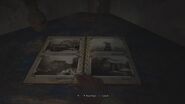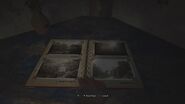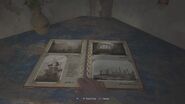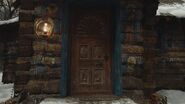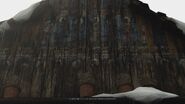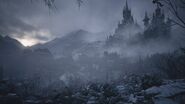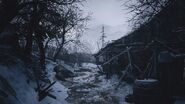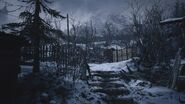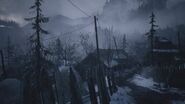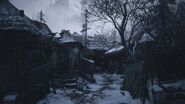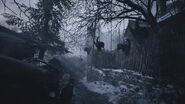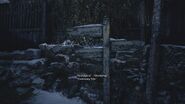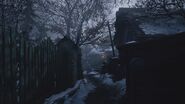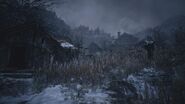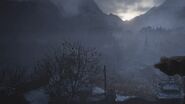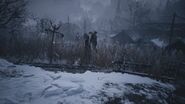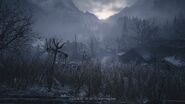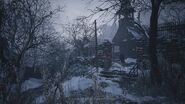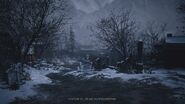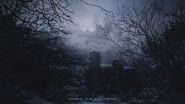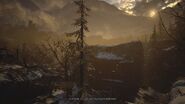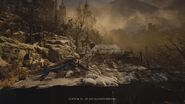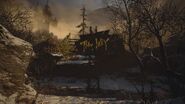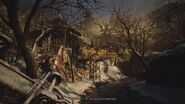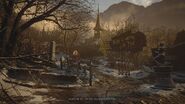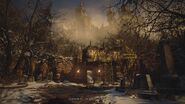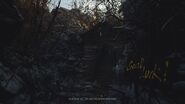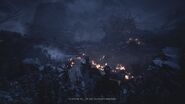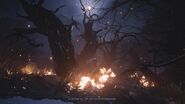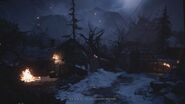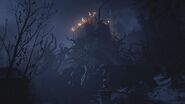(Capcom's primary storyline)

A map of the village. Note that the directions are reversed, with south being at the "top" and north at the "bottom".
The Village was a small unnamed community located in a mountainous region of Eastern Europe. It is the primary setting and eponymous location of Resident Evil Village.
History[]
There has been continuous or near-continuous human habitation of the mountain range for millennia. Although no exact age has been determined, Mediæval folklore would indicate the region was once the heart of a powerful kingdom so ancient that nothing else was known of them. Ruins left by this people included the remains of an underground city and four towering statues carved in the image of the "Four Kings", who mysteriously disappeared along with the entire population they presided over.[1] The village itself may have been established considerably later, with four people in particular named in myth as its founders: Nichola, Berengario, Guglielmo, and Cesare, who was a nobleman. The Pagan roots of this community are evident by Nichola's stone idol of a goddess, and a steel icon of the mythological Norse creature, Hræsvelgr.
During the Late Mediæval Period, efforts were made by the emerging states to expand into the mountains. One such state was responsible for the construction of a castle to the south in the 15th century, later known as Castle Dimitrescu, which would be inhabited by Cesare's descendants. Over time, foreign powers attempted to establish Orthodox Christianity to the region. As such, the villagers were treated with suspicion and contempt by the more pious of soldiers who had set up their own fort to the west, who saw them as either heretics or Pagans; a practice which would last well into modern day.[1][note 1] How successful these efforts were is uncertain, as even by the 19th century it would remain a refuge for people such as Norshteyn, who were ostracized from their own communities due to their religious beliefs.[2] Crystallized remains below the fort, and a stone relief depicting a demon with tentacles emerging from its head, suggest the Black God may have laid waste to the region during this time, possibly negating these attempts.
In the years leading up to the 20th century, the successive generations of Nichola, Berengario, and Guglielmo would lose their power, surviving only as gentry and finally as the petit bourgeoise. By at least the late Industrial Period, the Moreaus ran a clinic from an archaic reservoir in the north, the Heisenberg nobility established a mining factory in the region's northernmost alps, and the Benevientos became established dollmakers in the region, where they were known to operate from the seclusion of their fog-enshrouded home in the east. Only the Dimitrescus managed to retain noble recognition, though they had become regarded as dictators due to their tyrannical hold over the villagers for generations, resulting in them either abandoning their family lineage or dying out as recently as the 17th century, as suggested by Baroque-style interior in their family castle which had not become prominent until that time.[3]
Rule of the Four Lords[]
During the 1918-1919 Spanish flu, the village suffered considerable loss of life from sepsis and pneumonia; with cemeteries full to capacity, many of its inhabitants were laid to rest in the local Potter’s Field. Among those who’d succumbed to the sickness was Eva, the only daughter of a local woman by the name of Miranda. Grief-stricken at the loss of her only child, Miranda wandered into a nearby cave wherein she intended to take her own life, only to discover the Black God beneath the village. Upon making contact with it, she became infected with a mutagenic fungus known as the Mold, and in the process saw the memories of hundreds, if not thousands, of those who had died in the region spanning centuries, their consciousness and DNA consumed and assimilated with it; this included Eva, who had been devoured by it shortly after her burial. Convinced she could use her newfound abilities to bring her back to life, Miranda set her intentions on becoming the leader of the village, infecting the other villagers with the Mold to cure them of their sickness. Abandoning their Christian faith, they turned to worshipping her, interpreting her as a holy figure and a prophet of the Black God, thenceforth addressing her as "Mother". For decades afterward, Miranda would prey off their devotion, using them as test subjects to create the Cadou, a parasite she believed would turn its host into the perfect living vessel for a duplicate of her daughter's consciousness.
Despite her extensive research, all of her attempts to use the Cadou would prove unsuccessful, with most of her subjects either dying outright or mutating into Lycans, a pseudospecies of wolf-like monsters that began populating an old stronghold just beyond the village's perimeter. As with many others in the village, the noble descendants of the four houses who had established the region in ancient times were also lured into being experiments by Miranda. Out of numerous failures over decades which thinned their numbers, only Alcina Dimitrescu, Karl Heisenberg, Salvatore Moreau and Donna Beneviento survived, developing unique and aggressive mutations while retaining (most of) their cognizance. Considered unsuitable as candidates for Eva's revival, their ancient birth rights were nonetheless recognized and they were allowed to remain in the village to serve as its Four Lords. From the 1950s to 2021, the Four Lords each maintained a dictatorial rule over the village which, under Miranda's control, was unable and unwilling to leave for help. Despite this, they were still revered and worshipped alongside Miranda, albeit reluctantly.
Among the Four Lords, only Countess Alcina Dimitrescu seems to have garnered notoriety outside of the village, having inherited her rightful estate during the 1950s and reinstated her family's vintage winemaking techniques, which had fallen out of use since the Middle Ages, the most popular being Sanguis Virginis.[3] Widely regarded as a tyrant, she was attributed to the disappearance of numerous female staff under her supervision. At least one attempt was made on her life from a local villager who attempted to stab her with a poisoned dagger rumored to kill demons and monsters, but after this proved unsuccessful, the dagger was sealed away along with his corpse in her ancestral crypt.
Fall[]
- Main article: Village Incident
In February 2021, Miranda succeeded in tracking down a suitable host for her daughter, the infant Rosemary Winters. No longer interested in preserving the village, Miranda's departure gave the Lycans an opportunity to expand their territory, and within a few short nights nearly the entire population was killed, with Miranda and the Lords purging the rest upon her return. Miranda thereafter lured Ethan Winters, Rose's father, into assassinating the Four Lords, who were a liability to her. When the Black God at last awoke, the village was severely damaged by its emerging tendrils and the ensuing assault by the Bioterrorism Security Assessment Alliance and the Hound Wolf Squad led by Chris Redfield. What little was left of the village was annihilated when an N2 Explosive at its core was detonated.
Culture[]
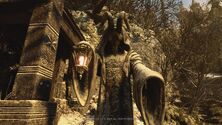
A statue with a human-shaped body and a goat's head
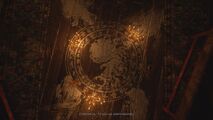
A magic ring depicting the Black God.
Over the course of its history, the village developed a unique culture which preserved traditions lost to much of Europe by the 21st century. Newspapers were outlawed under the decree of Mother Miranda to keep its inhabitants ignorant of the outside world,[4] ensuring their complete devotion to her and, unbeknownst to them, her experiments upon them. Isolated from outside influences, superstitious belief and magical thinking persisted throughout the region. This was especially apparent in the ritualistic circles and candle-adorned shrines giving reverence to her and the Four Lords who served under her, whose unique mutations from the Cadou endowed them with abilities and physical deformities that seemed supernatural to the vast majority of villagers, who were unaware why.
Some understanding of Miranda's connection to the Four Lords clearly existed among the villagers, though the full extent of the villagers' knowledge on this matter are unknown, for while Miranda continued to be worshipped solely as a benevolent god or angel, no such loyalty existed for the Lords beneath her, who were reviled and feared for their atrocities upon the region. It is thus uncertain whether the villagers were indebted to Miranda due to her ability to manipulate them into viewing her as their protector, or because of the mind-altering effects of the Mold she used on them.
Due to their unawareness of the complexities of Mold-based genetic engineering and their genuine belief in the occult, the villagers attributed the names of mythical creatures to Miranda's defected creations. Lycans and Moroi, words referring to "werewolves" and "vampires", respectively, were both used to describe the vicious wolf-like beasts and bat-like humanoid beings dwelling on the fringes of the village's outskirts. Countess Dimitrescu's daughters, three robed women able to dematerialize into swarms of flies, were referred to as "witches" by the locals, and an eerie elderly woman devoted to the Black God’s dark prayers was known only as the "Old Hag", furthering Paganistic practices and ideologies in the village. As such, cloves of garlic and necklaces of bone adorned the homes of the villagers, whose terror of stepping beyond their homeland continued to enforce their devotion to Miranda in the hope of warding off evil. A particular religious fascination with goats also existed, with the earliest being the carving of two statues of men with goat heads. In later traditions, villagers would make wooden talismans in the shape of goats, which were kept in shrines, and hang the heads of goats throughout the village from the sides of their homes or in trees.
Only one work of literature is known to have been produced in the village, a storybook written by an anonymous author titled Village of Shadows. It relays the tale of a young girl who becomes lost in a dense forest while picking berries with her mother, and as she ventures deeper and deeper into the wilderness, encounters four magical beings serving under a witch: The Bat Lord, The Dark Weaver, The Fish King, and The Iron Steed. The girl is trapped in a mirror by the witch, but is freed by her parents at the expense of losing her father, who in the end gives his life fighting the witch as the woodland around them burns.
Landmarks[]
- Village Church and Graveyard
- Luiza's House
- Ceremony Site
- Cave Church
Gallery[]
Sources[]
- notes
- ↑ The Japanese word used is ikyōto (異教徒) which would more appropriately refer to "heathens" or "pagans" rather than "heretics" and "infidels".
- references
- ↑ 1.0 1.1 Resident Evil Village (2021), file: "Officer's Diary".
- ↑ Resident Evil Village (2021), file: "Norshteyn's Labyrinths".
- ↑ 3.0 3.1 Resident Evil Village (2021), file: "Winemaking History".
- ↑ Resident Evil Village (2021), file: "Ernest's Diary".
| ||||||||||||||||||||||||||||
| ||||||||||||||||||||||||||||||||||||||||||||||||||


